The marketing persona or «buyer persona» refers to the definition of a fictional character endowed with the characteristics representing your target. 🏹
Discover how easy it is to find your buyer persona. Simply follow the 6 steps in this article, for amazing results!
Buyer Persona Definition
The definition of buyer persona is the idea of personalizing your target to better see the typical person to whom you’re going to sell your product or service. ✍️
As we said, this is a fictional representation of your “core customer”.
For example, if you’re a software development company selling marketing software for accountants, your marketing persona might be: “Paul, 43, self-employed, single, no children, likes to read and works late evenings and weekends”.
Pascal’s problem is that he’s old school, computer software isn’t his thing, so he needs a very intuitive tool to help him in his professional activity, as well as extremely responsive customer support. 🤔
That’s great, that’s exactly what you’re proposing (or at least, what you hope to propose)! 🌟 Now that you’ve got an idea of whom you’re going to sell your solution to, you’ll need to find those consumers!
Why create a Marketing Persona?
When you want to set up an offer, you need to create a marketing persona. You’re not going to sell word-processing software to a farmer 🐮. So it’s important to have a profile in mind so you can meet your prospects’ needs.
It’s essential to develop your fictitious customer to generate leads. By setting one up, you’ll be able to respond to:
- His or her needs.
- His or her expectations.
- Pain or frustration points.
- Know the buying path.
In this way, you’ll complete what’s known as a marketing pipeline. The sales pipeline is the process by which your potential lead becomes a genuine new customer.
It’s with the aim of getting to know your target‘s needs 🎯 that this buyer persona is set up.
How do you Create a Buyer Persona?
Your buyer persona should be based on real-world information and realistic goals, not just on people you want to hang out with. 🙊
Here’s how to create a fictional customer who’s a perfect match for your real-world business. 💘
Step 1: Define your Buyer Persona
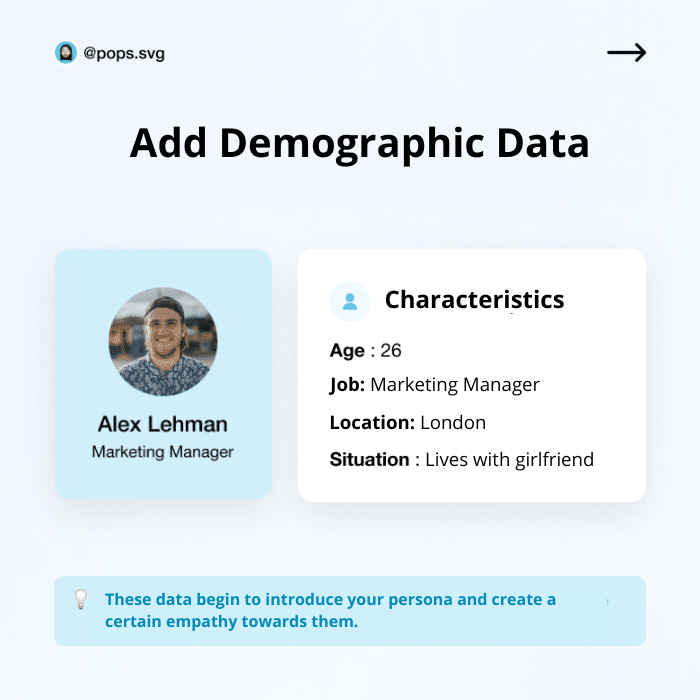
It’s time to get your hands dirty. ⚡
Who are your current consumers? What is the demographic of your social audience? Who are your competitors targeting? See our comprehensive guide to achieving product-market fit for a more in-depth look at these principles. 👈
But, meanwhile… 😏
Compile audience insights from your social media analytics, consumer database, dashboards 🚀 to focus on specific points such as:
- Check age, location, language, profession, and situation.
- For B2B: add company size and who determines purchasing choices.
Step 2: Add the information to create your Buyer Personae
The buyer personae’s personal information:
- Last name.
- First name.
- Age.
- Gender.
- Family situation 💍 or marital status.
- Where he lives.
- Social networks used.
- Internet use behavior.
The persona’s professional information:
- Profession.
- Business sector.
- Salary.
- His/her position in the company (if you’re targeting a B2C audience).
- Their ideal day at work.
- User preferences ❤️.
Product details for your marketing persona:
- The reasons why he or she turns to your product.
- Their specific characteristics.
- His buying behavior.
- Does he buy online 💻 or in-store?
- Why do they like the product?

Depending on the items and services you provide, your audience’s aspirations may be personal or professional. What inspires your users? What is their ultimate goal? 🎯
Step 3: Identify the Persona’s Motivations and Frustrations
On the other hand, they have “pain points”, we’ll see tips on how to deal with them later. 😖
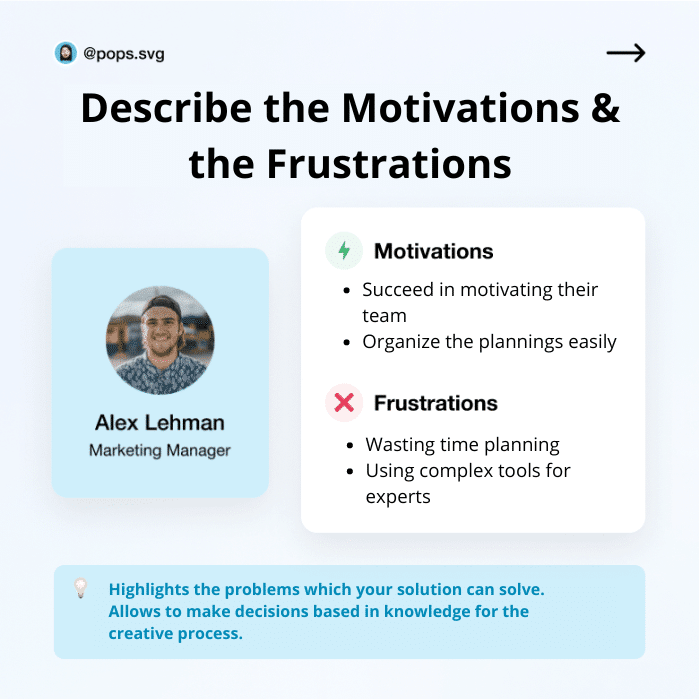
Simultaneously, ask yourself what motivates your target. 👇
What problems or inconveniences are your potential consumers trying to solve? What prevents them from succeeding? What are the obstacles to their achieving a goal? 🚩
Your staff and customer service are excellent resources for answering these questions. However, another important option is to participate in Q&A, or via online reviews. 👂 Here’s an article on how to make a customer satisfaction survey! 🥰
Step 4: Create Scenarios to find out How to help them
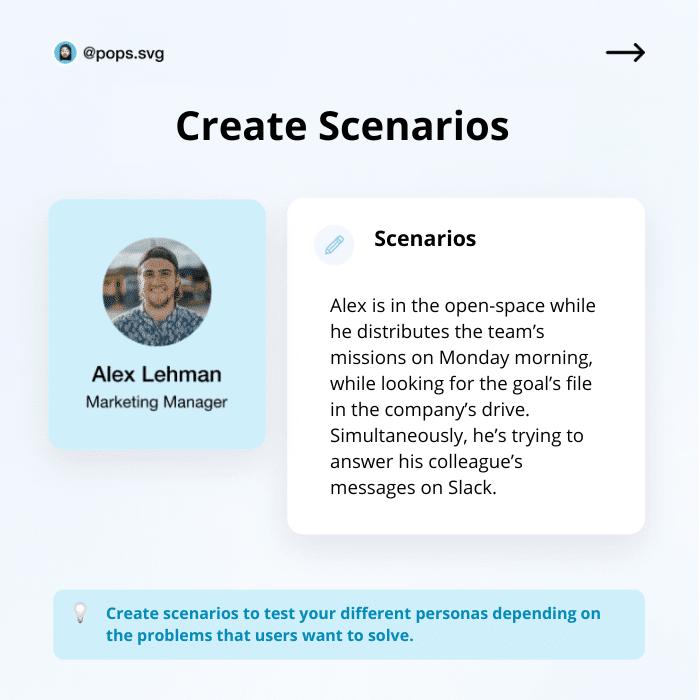
Now that you have a better understanding of your users’ goals and challenges, think about how you can help them. 🤝
To achieve this, create scenarios that highlight their issues.
This means looking beyond features to the real benefits your product or service can bring them. 🤔
A feature is what your product is or does. 🙌 A benefit is how your product or service makes your customer’s life easier or better.
Consider your audience’s main barriers to purchase, as well as where your followers are in their customer journey. Then ask yourself, “How can we help them?” 🏅
Step 5: Create Several Persona Buyers
Gather all these criteria and start looking for commonalities. When you combine these traits, you’ll have the basis for your distinct “customer personas”. 👍
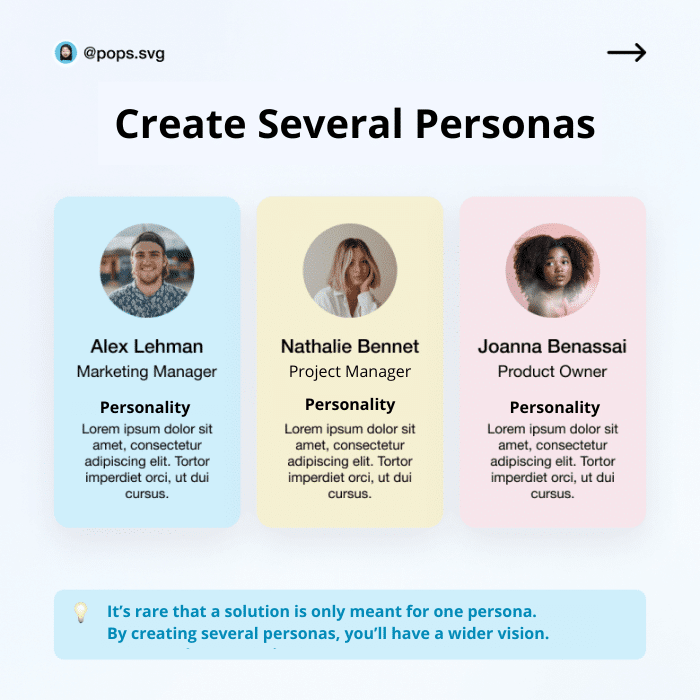
Give your persona buyer a name, a job, a house, and other distinctive criteria. You want it to feel authentic. 🤡
Let’s say you define a consumer group as 40-year-old, professionally successful, childless city women who love great restaurants. 💅 “High-Achiever Haley” could be your persona:
She was born in 1971 and is 41 years old. She takes spinning classes three times a week. Furthermore, she lives in Toronto and runs her own public relations agency. She drives a Tesla. 🚗 She and her boyfriend take two trips abroad each year and prefer to stay in boutique hotels. She is a member of a wine-tasting club.
You get the idea: this isn’t just a list of character traits! ⚠️
It’s an in-depth, face-to-face description of a potential consumer. It helps you see them as a person, rather than just a collection of data points. These criteria may not apply to every customer in your target market, but they help paint a concrete picture of an archetype. 👫
Aim for about the amount of information you’d expect to see on a dating site 😍 (but don’t forget to add “bread points”).
When developing your consumer portraits, be sure to simultaneously express who each persona is today and who they hope to be in the future. This allows you to start thinking about how your products and services can help them achieve their goals. ⌚
Step 6: Regularly Update your Marketing Personae
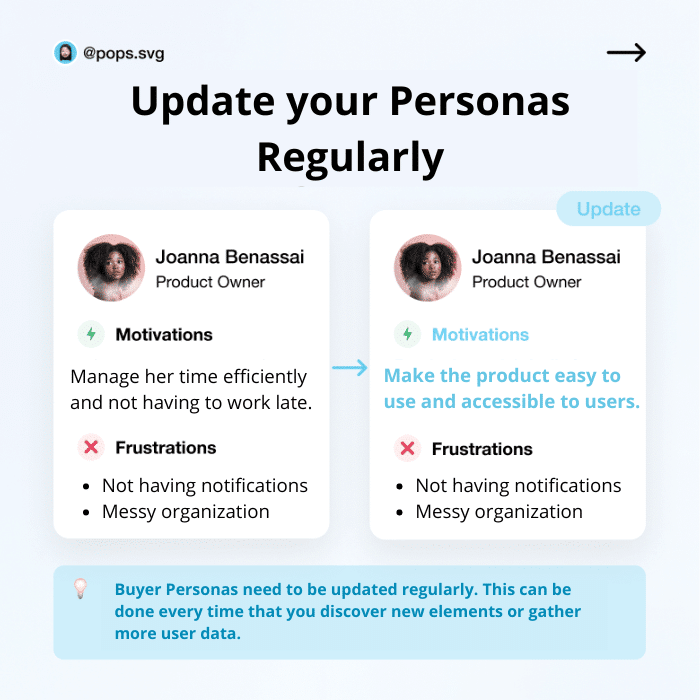
Your personas’ motivations and criteria may change over time. ⌛ You may also notice that you have new buyer profiles and that they have different motivations or frustrations.
Be sure to update them for each new product or service, modification of an offer, or simply to realign yourself with a new customer base. 💥
Otherwise, you risk not delivering the right message, to the right audience. 😱
Here are a few examples to get you started…
Examples of buyer personas
Example #1: B2B Buyer Persona
So that you can establish your own buyer persona, we’re going to take a fictitious example that you can then adapt to your offer. 🛍️
You’re a company specializing in ergonomic office chairs. 🏬 So you want to sell in France to professionals who work in offices, or even to Coworking spaces.
You will need to find the right person (the one in charge of managing supplies) and therefore target them perfectly.
- We’re going to need the personal data of this potential target:
- Now that we have the basic information, let’s move on to the professionals:
- We’ll now need the company’s information:
Here we have only basic information (but it’s still important). 🤔
We can start with this info and then flesh it out.
We’ve seen the B2B target, now we’ll move on to a B2C target. The process for creating a B2C persona is much the same as for a B2B target. 🏹
The term B2C stands for “Business to Consumer” and it means you’re going to sell 💰 a product or service to an individual.
Without further ado, let’s move on to an example of a B2C buyer persona.
Example #2: Creating a B2C marketing persona
You specialize in selling socks online. 🧦 You’re just starting out and your target audience is in France.
So we’ll start with the potential customer‘s personal information. ✍️
- We’ll also need her professional data:
B2B and B2C Buyer Personas: What are the differences?
It’s not very complicated – here it is! 👇🏼
- A B2B buyer persona represents a typical profile of a decision-maker or corporate customer, based on demographic, professional and behavioral data. 🧠 It focuses on business-related needs, challenges and motivations, often involving longer buying processes and decisions based on profitability and efficiency.
- A B2C buyer persona describes an individual consumer, focusing on personal characteristics, interests, and customer behaviors. 💸 Decisions are often more emotional and impulsive, influenced by factors such as price, brand and personal tendencies.
Buyer Persona vs. User Persona
We also need to make sure you don’t confuse the buyer persona with its cousin: «user persona». 🚫
They’re not cousins, but here are the main differences between the two terms:
- Buyer personas are not always users, although they can be.
- User personas focus on specifics such as usability.
- Buyer personas are more concerned with long-term objectives.
- Don’t forget that a buyer persona can be a group of decision-makers with different objectives and expectations.
- When building a user profile, keep in mind past skills and customer experience.
Well, I hope that helps clarify what a user persona is. So now, let’s take a look at the different types of buyer personas there are! 👇
The Different Types of Buyer Personas
When you start working on your personas, you might ask yourself, “What are the different types of personas?” It should be simple to adapt one for your business from there, right? 🧐
That’s not exactly how it works. 🔍 There’s no predefined list of globally recognized personas from which to draw, nor any standard for how many profiles you need. After all, every company (no matter how many competitors it has) is unique – and therefore its buyer personas must also vary. ✍️
In general, a company’s buyer personas may belong to the same or comparable categories (for example, a marketing specialist, an HR representative, an IT manager, etc.) 🤓
However, 💡 a company’s different personas and the quantity you require will be tailored to who your target audience is and what you provide your customers.
Our Tips for Communicating with your Buyer Persona
Now that you know what a buyer persona is and how to identify them, let’s take a closer look at how to communicate with them properly: 👇
1. Identify the “pain points” of my personas
You’ve collected and analyzed buyers’ answers to the following questions: 👂
What is their problem? What are their objectives? What’s stopping them from buying?
Your goal: to provide precise answers to each problem/objective/disincentive to purchase, by buyer personality category, through high value-added – and widely distributed – web content.
How to do it: present an argument against each identified obstacle to purchase. Explain how your product or service specifically addresses each goal. 🎯 To make sure you’ve understood and integrated each issue into your product or service.
Your pitch must be relevant to your customer persona, it must ensure continuity of the customer journey and that conversion rates are optimized. ⚡
2. Find inspiration for better targeting
You’ve identified the type of content that interests your prospects and customers. From there, you’re sitting on a gold mine! 🪙
Remember, inbound marketing allows you to attract customers organically by focusing your communications strategy on their interests – not yours!
Self-promotion is pointless, but how can you boost your content creation regularly? Without burning yourself out in the long run… 🤔
You need to define your personas well, thanks to a rich database, so you can vary the topics you cover and never bore your audience. 👍
3. Adapt communication to each persona
Good content is not only well written, it’s also well distributed! 📣 To increase conversion, you truly must ensure that your content is widely quoted and shared. This means publishing on the right distribution channels.
It’s by exploiting identifiable data on your personas (socio-professional category, search, position within the company, etc.) that you identify the most suitable marketing channels.
Your potential customers can easily access, read and share the information. 👀 Not only will you achieve your goals with precision, but they’ll also be communicating on your behalf!
4. Have a well-functioning customer journey
Buyer personas provide you with exclusive insights into the workings of your most qualified prospects. You know a lot about these personas, from their favorite social media sites, such as LinkedIn, to the way they communicate including their career ambitions, and you can use this knowledge to your advantage and theirs. 👌
Work on developing content strategies that these personas want to read on LinkedIn, for example. As well as marketing methods that highlight the goals and challenges of your buyer personas. 🤗
When you write, promote and sell with real people in mind – your most qualified prospects – you’ll start to see significant growth in your prospecting funnel.
The benefits of good personas
🚀 Buyer personas can be used in product development to create product roadmaps. Personas will help you identify and prioritize adjustments to your product based on your consumers’ most pressing needs.
🎯 Buyer portraits can be used in marketing terms to develop effective tactics. Personas, for example, are essential for developing a marketing content strategy. They help target keyword research efforts and serve as a reference when writing content. They can also help identify and prioritize promotional initiatives.
🤝🏻 Buyer personas can also help your sales staff develop relationships with potential consumers. Your sales team will be much more productive if they understand what prospects are going through and are prepared to solve those problems.
👩🏻💻 Finally, personas can be used by customer support teams to better serve your customers.
Your customer service department will be able to show greater empathy if it is taught about the difficulties your customers are trying to solve with your product, and the frustration they feel when things don’t work out. When faced with an irritated consumer, a little sympathy can go a long way. 👌
Recap: Who is my Buyer Persona?
In this article, you’ll find the definition of buyer personae, why they’re important for your sales prospecting and how to find them via LinkedIn, using software like Sales Navigator and Waalaxy, of course! 🌌 (See FAQ below for more details).
Now, let’s look at some tips about the buyer personas to finish: ⏬
👉 Every time you make a choice about your social media content or multichannel marketing plan, keep your customer personas in mind. If you treat these personas well, you’ll develop a relationship with the real consumers they represent, which will increase brand loyalty.
👉 Create buyer personas to better understand your consumers, and make sure everyone on your team understands how to target and help them effectively. This will help you improve reach and boost your conversions.
👉 Buyer personas are query-based profiles that reflect your target audience and can help you optimize essential parts of your support. It’s essential to define the types of personas who need your solutions and the problems you’re helping them solve.
Article FAQ
Why is the buyer persona important?
The buyer persona is important because it keeps you focused on your customers’ needs rather than your own. 💡
Consider your personas every time you make a decision about your social marketing plan (or overall marketing strategy). ✅
Does a new marketing campaign meet the needs and objectives of at least one customer profile? If not, you need to re-evaluate your idea, even if it sounds exciting. 😬
Once you’ve developed your personas, you can produce organic posts and ads on social networks that speak directly to the customers you’ve identified. Advertising, in particular, offers highly sophisticated targeting capabilities that can put your ad in front of the exact individuals you want to see. 🧲
If you would like to know more about this, here’s the full guide with everything you need to know about LinkedIn ads! 👈
Build your strategy around helping your personas achieve their goals, and you’ll develop a relationship with the real customers they represent. It all comes down to building customer loyalty and trust to accelerate your process. 🙏
What can B2b buyer personas be used for?
B2b buyer personas can help sales and marketing teams better target their potential customer! 🏹 Here’s an article on how your teams can work better together!
Therefore, one of the most obvious benefits of creating a persona is that it gives you consumer insights and cross-departmental alignment. ⚖️ This ensures that marketing, product development and customer service are all on the same wavelength when it comes to your ideal consumer.
Now that you know all the steps involved in creating your personas, 👏 you’ll also find that the act of creating a customer persona is enlightening in itself.
To create a buyer persona, you first need to ask yourself detailed questions about your potential consumers, 😮 and this exercise will help you see aspects you hadn’t noticed before.
You can then compare your answers with those of your colleagues, which will reveal any discrepancies in viewpoints and prompt the interviews to remedy them. 💡
This is important because you can then use your portraits to guide the course of your B2B sales strategy! 👈
How do I find buyer personas on LinkedIn?
To find future customers on LinkedIn, you first need to define your buyer persona.
You can then use filters in your LinkedIn query to make it more precise, and even use Sales Navigator if you want to get qualified results. 🔥In this article, you’ll find all the details on how to do it!
Now, let’s see how to find them with precise search filters. 👇
Use filters to find your buyer persona on LinkedIn
You can use the filters offered by Sales Navigator to highlight only those portraits that match your persona. 🔎
Note that Waalaxy works with all types of LinkedIn account, premium or not. But, to really maximize its potential, it’s highly recommended to use a Sales Navigator account. ⚡
- 👉 This way, if you want to target James, “an accountant” from “France”, you can set the filters to find him:


- Now you have a list of 1000 prospects that you can contact via LinkedIn thanks to Waalaxy:

Here’s a tutorial on how to import your LinkedIn personas into your Waalaxy automation software: ✨
Please note that Sales Navigator searches only give access to the first 2500 results. 👌 If your search contains more than 2500 results, and you’d like to access all of them, you’ll need to split your search into several smaller queries of 1000 personas, with exclusive filters to find your customers on LinkedIn.
I hope that with this article, you’ll know exactly how to define your buyer persona and how to find them on LinkedIn! 🚀









